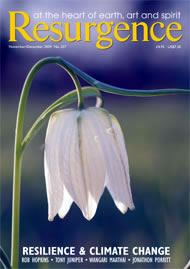We have chosen a flower for the cover of this issue to illustrate ‘Resilience’. Blossoms and flowers are resilient. They stand out there in the wind, in the rain, in the snow, in sunshine – day and night – unperturbed, undiminished. They are resilient because they are flexible and fragrant, pliable and pleasant, supple and soft, tender and tolerant, gentle, adaptable and light.
Flowers take their nutrients from the soil, moisture from the rain and energy from the sun. They need no fossil fuels to flourish: that is why they help to regulate the climate rather than destabilise it.
Flowers are very useful members of the Earth family. They provide nectar for the bees to make healing honey, beautiful blossoms that develop into nourishment, and an uplifting aroma to please human hearts.
They show that we are all related, we are all connected, we are all an integral part of the web of life, and we all exist within the context of mutuality and reciprocity. This is why flowers benefit everyone without discrimination. They give their fragrance and fruits with unconditional generosity: saints or sinners, poor or rich, humans or animals, bees or wasps – all are invited to enjoy the abundant gifts of flowers.
Flowers inspired poets like Wordsworth, who delighted in daffodils, and painters like Van Gogh, who celebrated sunflowers. The Buddha holds a lotus flower in his hand to teach wisdom and enlightenment while Lakshmi, the Indian goddess of prosperity, stands on the lotus to show that true wealth is neither money nor gold nor diamonds, but pure water, clean air, healthy soil and Nature in good heart, of which the lotus is a potent symbol. Lakshmi asks us all to include flowers in our families as they are the real fortune. The Bible teaches us to live like the lilies who are graceful and fulfilled and totally at ease within themselves, without any need for toil or struggle.
If we were to derive our energy from the sun, wind and water as flowers do, our energy supply would be assured and sustainable. If our economy could be as elegant as flowers, if our businesses could be as beautiful, if trade could be as tender and tolerant, if politics could be as pleasant, if our society could be as supple and soft as flowers, then we would have a resilient economy, resilient trade, resilient politics and a resilient society. So why not be like flowers and act like flowers?
Resilient flowers need resilient fields and forests to flourish. Wild flowers need wild fields and forests. Forests are the lungs of the Earth and are a guarantee of a stable climate as they host the harmonious dance of carbon and oxygen that is the lifeline of all living beings.
Carbon trading, carbon sequestration and umpteen other commercial or technological solutions are secondary: the first and foremost step to ensure climate stability is to protect, honour and celebrate our flowers and forests. When I look at our urban conglomerates, our housing estates, our industrial landscapes and our ever-enlarging business parks, I wonder: Where have all the flowers gone? Where have all the forests gone? Let us bring them back. Let there be a meeting of Nature and culture in our world.
When you read these words, it will soon be Christmas and you may be contemplating a Christmas tree. Let us start a new culture: rather than uprooting a tree and bringing it into the house to honour it, why not go out with your whole family and plant a tree? Let each and every tree be a noble Christmas tree. Let Father Christmas fill our stockings with seeds and seedlings. Let us plant flowers, trees and forests all around us; let us see and acknowledge “heaven in a wild flower” as William Blake exhorted, and let us stop those who are cutting down our rainforests for short-term commercial gain.
Trees and flowers are the answer. Now, what is the question?
SATISH KUMAR







